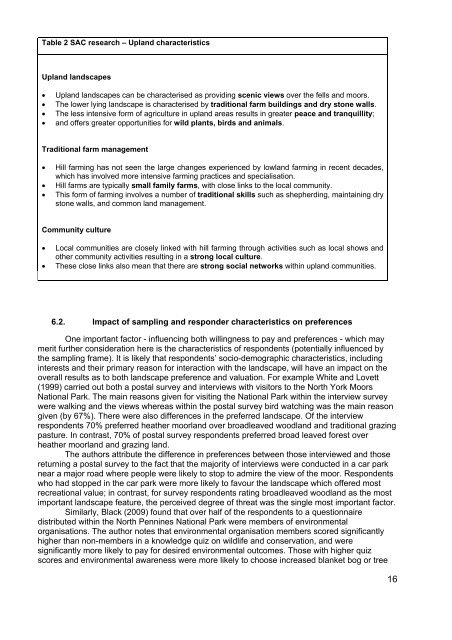Public Attitudes and Preferences for Upland Landscapes - Defra
Public Attitudes and Preferences for Upland Landscapes - Defra
Public Attitudes and Preferences for Upland Landscapes - Defra
Create successful ePaper yourself
Turn your PDF publications into a flip-book with our unique Google optimized e-Paper software.
Table 2 SAC research – Upl<strong>and</strong> characteristics<br />
Upl<strong>and</strong> l<strong>and</strong>scapes<br />
• Upl<strong>and</strong> l<strong>and</strong>scapes can be characterised as providing scenic views over the fells <strong>and</strong> moors.<br />
• The lower lying l<strong>and</strong>scape is characterised by traditional farm buildings <strong>and</strong> dry stone walls.<br />
• The less intensive <strong>for</strong>m of agriculture in upl<strong>and</strong> areas results in greater peace <strong>and</strong> tranquillity;<br />
• <strong>and</strong> offers greater opportunities <strong>for</strong> wild plants, birds <strong>and</strong> animals.<br />
Traditional farm management<br />
• Hill farming has not seen the large changes experienced by lowl<strong>and</strong> farming in recent decades,<br />
which has involved more intensive farming practices <strong>and</strong> specialisation.<br />
• Hill farms are typically small family farms, with close links to the local community.<br />
• This <strong>for</strong>m of farming involves a number of traditional skills such as shepherding, maintaining dry<br />
stone walls, <strong>and</strong> common l<strong>and</strong> management.<br />
Community culture<br />
• Local communities are closely linked with hill farming through activities such as local shows <strong>and</strong><br />
other community activities resulting in a strong local culture.<br />
• These close links also mean that there are strong social networks within upl<strong>and</strong> communities.<br />
6.2. Impact of sampling <strong>and</strong> responder characteristics on preferences<br />
One important factor - influencing both willingness to pay <strong>and</strong> preferences - which may<br />
merit further consideration here is the characteristics of respondents (potentially influenced by<br />
the sampling frame). It is likely that respondents’ socio-demographic characteristics, including<br />
interests <strong>and</strong> their primary reason <strong>for</strong> interaction with the l<strong>and</strong>scape, will have an impact on the<br />
overall results as to both l<strong>and</strong>scape preference <strong>and</strong> valuation. For example White <strong>and</strong> Lovett<br />
(1999) carried out both a postal survey <strong>and</strong> interviews with visitors to the North York Moors<br />
National Park. The main reasons given <strong>for</strong> visiting the National Park within the interview survey<br />
were walking <strong>and</strong> the views whereas within the postal survey bird watching was the main reason<br />
given (by 67%). There were also differences in the preferred l<strong>and</strong>scape. Of the interview<br />
respondents 70% preferred heather moorl<strong>and</strong> over broadleaved woodl<strong>and</strong> <strong>and</strong> traditional grazing<br />
pasture. In contrast, 70% of postal survey respondents preferred broad leaved <strong>for</strong>est over<br />
heather moorl<strong>and</strong> <strong>and</strong> grazing l<strong>and</strong>.<br />
The authors attribute the difference in preferences between those interviewed <strong>and</strong> those<br />
returning a postal survey to the fact that the majority of interviews were conducted in a car park<br />
near a major road where people were likely to stop to admire the view of the moor. Respondents<br />
who had stopped in the car park were more likely to favour the l<strong>and</strong>scape which offered most<br />
recreational value; in contrast, <strong>for</strong> survey respondents rating broadleaved woodl<strong>and</strong> as the most<br />
important l<strong>and</strong>scape feature, the perceived degree of threat was the single most important factor.<br />
Similarly, Black (2009) found that over half of the respondents to a questionnaire<br />
distributed within the North Pennines National Park were members of environmental<br />
organisations. The author notes that environmental organisation members scored significantly<br />
higher than non-members in a knowledge quiz on wildlife <strong>and</strong> conservation, <strong>and</strong> were<br />
significantly more likely to pay <strong>for</strong> desired environmental outcomes. Those with higher quiz<br />
scores <strong>and</strong> environmental awareness were more likely to choose increased blanket bog or tree<br />
16
















